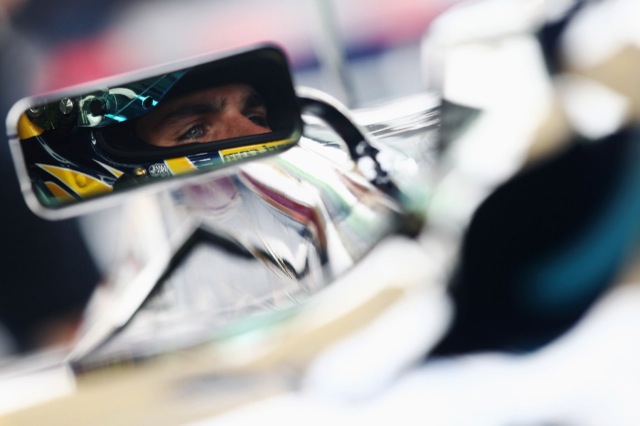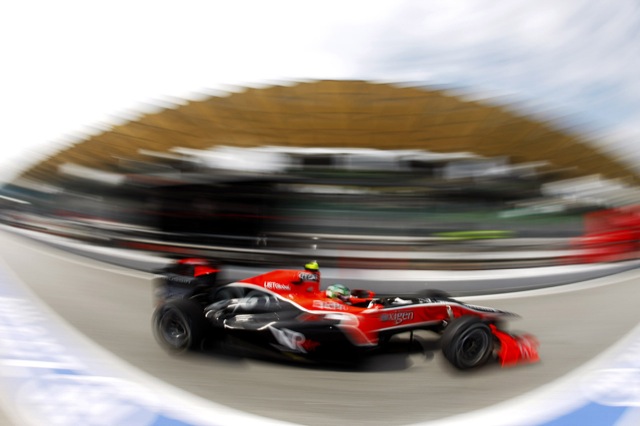The history of Formula One has seen ten seasons where there were three or more first-time winners, and having looked back at the most recent six, this is the third and final instalment, assessing the first four. We’ve haven’t yet found a podium that featured all three first-timers, but we have found some uncanny resemblances in 2003 and 1995, where the second new-winner had one previous and one future victor. So onwards to the 1971 campaign…
1971: Andretti, Gethin & Cevert
Starting fourth on the grid for the first race of the 1971 season, Mario Andretti was already considered a driver with a great career ahead of him. The race in South Africa was particularly hot, and Howden Ganley was treated for heat exhaustion. Also, Pedro Rodriguez’s BRM car started to melt and the Mexican was forced to retire as his feet started to burn. But it was the 31 year old Italian-American who took to the podium as the winner, joined by Jackie Stewart and Clay Regazzoni. Clay won for the first time the year previous and Jackie was already a world champion.
The second new-winner of ’71 was Peter Gethin, driving for BRM and competing in his first full season in Formula One. Gethin’s win came at Monza in Italy and the final result is the closest in the sport’s history. Gethin won, but on the final lap, the Briton was in fourth. A few bold moves later and he crossed the line in the lead, just 0.01s ahead of Ronnie Peterson’s March, who was himself only 0.08s ahead of François Cevert’s Tyrrell. Add another 0.09s to Cevert’s time and you’ll find Mike Hailwood in the Surtees, who was 0.43s ahead of Howden Ganley’s BRM. For the podium though, Peterson hadn’t won yet (his time would come in 1973) and Cevert hadn’t won either, although he would later in the year.
And that maiden win for François Cevert came at the very last race of the year in America. Like Peter Gethin before him, Cevert’s maiden victory would also be his last as both drivers only won the once. However, it was a pretty convincing win at Watkins Glen, with the French driver crossing the line 40s ahead of his nearest rival that day, Swiss driver Jo Siffert. Unfortunately for us though, Siffert had won his first race in 1968 and Peterson, as we’ve already seen, would win a couple of years later.
1962: Hill, Clark & Gurney
We need to go back almost ten years now to find the previous season with three or more new-winners, and 1962 featured some of the biggest names in motor sport history; Graham Hill, Jim Clark and Dan Gurney. Hill would go on to become a double champion, and in fact he won his first title in the same year as his first win. Clark would also go on to take titles, and American racer Dan Gurney would become a regular feature on the podiums throughout his career.
Hill started off the 1962 season in style, winning the very first round in Zandvoort in the Netherlands. Starting in tenth, Hill clawed his way up to the top, and after leading for 68 of the 80 lap race, he found himself being the first driver to see the chequered flag, almost half-a-minute before anyone else. Joining him in the celebrations were fellow-Brit Trevor Taylor and Ferrari-driver Phil Hill. This was to be Taylor’s only podium of his career, and Philip Hill had previously taken his maiden victory in 1960.
Two rounds later and this time it was Jim Clark’s turn as he won the Belgian Grand Prix on the old Spa Francorchamps circuit in the Ardennes Forest. Clark came out of the final corner 44s ahead of Graham Hill, who was himself over a minute earlier than Phil Hill. Therefore, the podium was almost akin to the second win in ’95 and ’03, with previous first-time winner Graham Hill in the second spot, but as already mentioned, the other Hill had won three races prior to Belgium 1962, and taken the 1961 title.
New-winner number three was Dan Gurney, driving for Porsche and winning the following race – round four – in France. Like with the two previous maiden victors, Gurney won in impressive style, leading by a whole lap on the last tour of the Rouen-Les-Essarts circuit. Following Gurney over the line (although I think the word “following” is perhaps a little misleading) was South African racer Anthony Maggs and two laps down and in third was Richie Ginther. Maggs never won in his 27 race career, and Ginther would have to wait until 1965 before taking home the biggest trophy of the day.
1961: Baghetti, von Trips & Ireland
Only going back by one year, we find ourselves in 1961; the year in which Stirling Moss last competed in a grand prix. Although this year saw three new-winners, this was largely down to the well-prepared Ferrari team who dominated the season with a competitive engine. The only non-Ferrari to win was the Lotus team, who took victory twice with Moss and once with Innes Ireland, who took the final win of the year in the outdated car.
The first new-winner of 1961 is also perhaps the saddest. Wolfgang von Trips put himself firmly in the record books by winning the second round of the season at Zandvoort, leading Phil Hill and Jim Clark over the line. Hill won the year previous, and Clark would win the following year. von Trips won again in Britain at the fifth round, and Moss would get his own back by winning in Germany at the following race.
Wolfgang was on the verge of winning the title, but in Italy, tragedy struck as his car clipped Jim Clark’s Lotus. The Ferrari was launched into the air, smashed into a barrier and von Trips was thrown from the vehicle to his untimely death. 15 spectators were also killed in the horrific accident. Wolfgang’s legacy lives on though, as the kart track he built in Kerpen is where Michael Schumacher completed his first racing laps, some fourteen years later.
New-winner number two, also in the dominant Ferrari, was Italian racer Giancarlo Baghetti. The race at Reims-Gueux was another closley-ran event with Baghetti crossing the line just 0.1s ahead of Gurney. A further minute later and Jim Clark would come through in third, but both drivers wouldn’t win in 1961.
Onto the all-important third new-winner of the season, Innes Ireland. Driving for Lotus, Innes took the final win of the season at Watkins Glen in America. On the 100th and final lap, the Yorkshire-born driver was 4s ahead of local racer Gurney and 49s ahead of fellow-Brit Tony Brooks. Brooks had already won in 1957, so once again, the podium we saw at the 2008 Italian Grand Prix was, so far, the first.
1959: Brabham, Bonnier & Bruce
1959 saw two Australasian winners – something that isn’t often said in Formula One – both of whom won for the first time and were joined in the record books by a new Swedish winner. Like with Graham Hill, Jack Brabham started of his season on a high note, taking his maiden victory at the very first round in Monaco. He was joined by Tony Brooks and Maurice Trintignant on the make-shift podium in the principality. By the end of the year, Australian Brabham would still be leading the driver’s title, beating Brooks by four points.
The second new winner of 1959 was Joakim Bonnier, a Swedish driver who at the age of 29, took his one and only win in Formula One. Again at Zandvoort and the closet race in the championship to a home-grand prix for Bonnier, the one-time winner took the chequered flag 14s before Jack Brabham, and 83s ahead of third placed driver Masten Gregory. So Brabham was a 1959-winner, but Gregory would never lift the victor’s trophy in his 8-year F1 career.
The final new-winner of 1959 is perhaps the most famous, for the name still lives on to this day in Formula One – Bruce McLaren. Hailing from New Zealand and also being possibly the most famous New Zealand-raised racing driver (I can’t think of any others right now), Bruce would win at the final round of the season at Sebring in America. It would be the first of only four victories for McLaren, and despite never winning the coveted driver’s championship, his team, after merging with Ron Dennis’s Project Four, would go on to become one of the sport’s most successful constructors. McLaren’s maiden win at Sebring was celebrated with Maurice Trintignant and Tony Brooks, both of whom won races in previous campaigns.
Wrap-Up
So that’s it. That is all the seasons so far that have featured three or more first-time winners, and their podiums have been analysed. Not one came even close to Sebastian Vettel’s glory of last weekend, when he shared the champagne with fellow 2008 first-timers Heikki Kovalainen and Robert Kubica. That podium was the first of its kind, and judging the fact that it took 59 years to happen, it would seem as though we are in for a long wait before it is repeated.
I hope you’ve enjoyed looking back through the years as much as I’ve enjoyed writing this series – I learned many a’thing by looking closely at various results and driver biographies, and of course we now know that the 2008 Italian Grand Prix result was not just special, but also unique to this day.


















[…] Three First-Timers On A First-Timers Podium: Part III […]
[…] Three First-Timers On A First-Timers Podium: Part III […]
“I hope you’ve enjoyed looking back through the years as much as I’ve enjoyed writing this series…”
very much so, thank you for the insight.
Great stuff Ollie. You really had me going with the Brabham, Bonnier and Bruce title. I was racking my brains for a winning driver with Bruce as his surname.
There are some other NZ drivers. 1967 champion Denny Hulme and the man who was so unlucky that Mario Andretti said that if he became an undertaker people would stop dying. Chris Amon.
Hehe, I’m pleased my alliteration kept you guessing. 🙂 Of course, the unluckiest driver in Formula One, Chris Amon. That’s a funny line from Andretti, but also probably quite true.
I’ve really enjoyed this series, Ollie. Thank you very much for proving that the Italian Grand Prix was even more remarkable than I first thought 🙂
Great job, Ollie – researched with the care and patience of an Alianora, then written with style and flair. Some good memories in there too – for an old geezer like me. 😉
Hehe. I did make a couple of fumbles, but that’s why I love having the comments open. For me, the best bits are always reading the article’s extensions – that’s where the real knowledge is. 🙂
Pleased you all enjoyed it.
researched with the care and patience of an Alianora {Clive – 2 comments ago}
[blushes vigorously] Though it is true that Ollie’s done some really good research for this series of entries.
Very good research from you Oliver 😉